ASUS Maximus Extreme - the Extreme Benchmarker's Choice?
by Rajinder Gill on December 10, 2007 8:00 AM EST- Posted in
- Motherboards
Extreme cooling results
| ASUS Maximus
Extreme Dual-Core Overclocking / Benchmark Testbed |
|
| Processor | Intel Core 2 Duo Q6850 Dual-Core, 3.00GHz, 4MB Shared Cache, 9x Multiplier, 1333FSB |
| CPU Voltage | 1.300V |
| Cooling | Various - Dual Rotary Cascades made by LittleDevil and Johann |
| Power Supply | OCZ Pro Xstream 1000w, PCP&C 1200w |
| Memory | OCZ DDR3 PC3-14400 (DDR-1800) Platinum Edition (2G/4GB) |
| Memory Settings | 4-4-4-12 1N (DDR3-1066 Base) |
| Video Cards | MSI 8800 GTX |
| Video Drivers | NVIDIA 169.09 |
| Hard Drive | Western Digital 7200RPM 250GB - WD2500KS |
| Optical Drives | Plextor PX-755A |
| Case | Dimastech benching table |
| BIOS | 0803 |
| Operating System | Windows XP Professional SP2 |
| . | |
3D Mark 2001SE CPU @ 4.88GHz GPU @ 861/1000
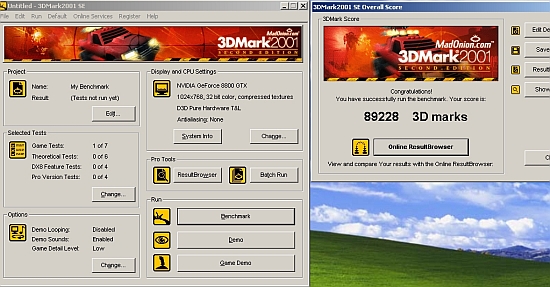 |
3D Mark 2003 CPU @ 4.88GHz GPU @ 861/1000
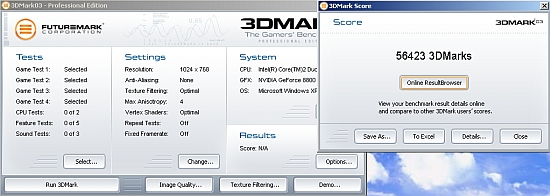 |
3D Mark 2005 CPU @ 4.88GHz GPU @ 861/1000
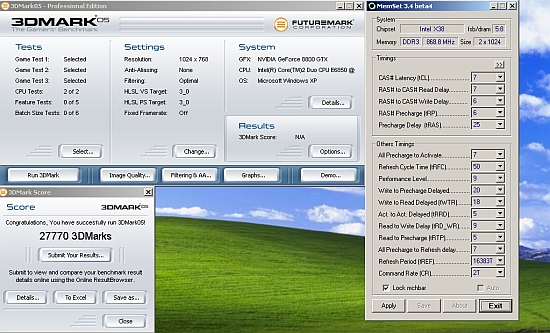 |
Aquamark 3 - CPU @ 5.084GHz GPU @ 840/1000
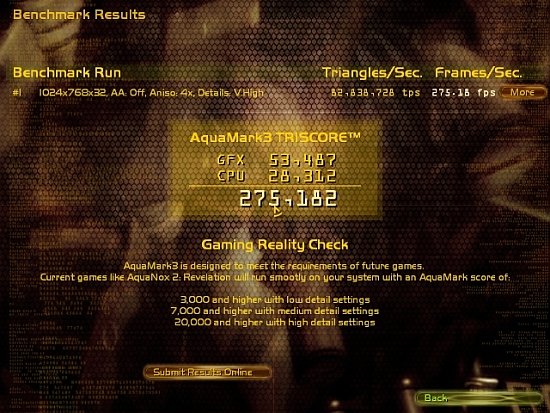 |
Super Pi 1M - CPU @ 5.084GHz
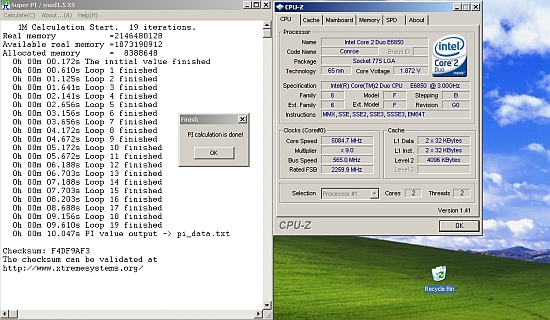 |
The 266 Northbridge strap worked up to 550FSB for us; at higher FSB speeds, we used the 333 strap and the 5:8 memory divider. The lowest Performance Level (tRD) we managed to hold stable over 560FSB on both the 333 and 400 straps was 9. VNB on our test board needed to be at least 1.71V and up for runs over 540FSB. RAM was another area we did not stress too far. The board overvolts VDIMM by around 0.05V, so we try to stay under 2.2V even for short sprint benchmarks.
The extreme cooled benchmarking was the one area we thought this board would really excel, and initial testing was very promising. We had no problems booting up at 9x570FSB within the first 10 minutes of each benching session. As time progressed, we found that we had to drop the FSB levels in order for the board to remain stable. Initially, our E6850 CPU was showing no signs of error during 3D benchmark testing at 565FSB (5.085GHz). Ten minutes later, any attempts to repeat or improve our scores proved futile. We checked cascade evaporator temps and contact, to ensure that inadequate cooling under heavy load didn't cause the decrease in stability.
Ambient temperatures in our test area were 8C, providing both the CPU and GPU cascades with plenty of support under heavy load. We checked our findings with a few extreme benchmarkers, to see if this "cold-bug" issue only occurred on our sample motherboard. Unfortunately, the answers we received in reply all suggested similar issues. The first boot into XP over 5GHz CPU speed is no problem, but subsequent re-boot attempts are limited to CPU speeds under 4.95GHz. The issue itself does not appear to be limited to particular CPUs either; we have heard examples of 45nm QX9650's succumbing to the same problem. It is probable that this issue involves PWM overvoltage and/or over-current protection. Benchmarks like Super Pi 1M still are fine at higher FSB speeds, while a slightly heavier load like Aquamark 3 fails after the initial attempt.
In this case using less Vcore than the absolute threshold for the circuit to trip may actually help achieve better stability. In our case, the only workaround for this situation was to bench for 10 minutes at a time, shut the board down, let everything return to ambient temperatures and then start again. If this issue is common, users with LN2 will be again hunting for modifications/BIOS fixes and perhaps even board revisions to enable true extreme benchmarking. Due to this constant on/off procedure and the attendant time constraints, we were not able to fine-tune the board to its full capabilities. Still, we are satisfied with our results.










27 Comments
View All Comments
markglh - Sunday, January 13, 2008 - link
Does the Thermalright Ultra-120 Extremem fit ok on this motherboard in a position so that it blows air out of the case? I was worried that the fusion waterblock and the heatsink at the top of the board might be too tall.thanks.
astronaute - Wednesday, December 26, 2007 - link
Can someone explain please why in BIOS screenshots we can see FSB 400 and QX6600 FSB is more then 1000 ?Sorry if my question is stupid :)
Rajinder Gill - Sunday, December 30, 2007 - link
The BIOS screenshots shown are provided only to illustrate which BIOS functions are available for the user. They have no direct correlation whatsoever with a Q6600 or it's FSB.regards
Raja
qquizz - Thursday, December 13, 2007 - link
With a name like Maximus Extreme the board better be one bad mofo, err... i mean mobo.Zak - Monday, December 10, 2007 - link
Something's not right, C2D Extreme and 8800Ultra??? I get over 12000 in 3D Mark 2006 with a $99 Gigabyte mobo, 3GHz C2D @3.8Ghz with Tuniq Tower, 800MHz DDR2 and 8800GTX slightly overclocked.Z.
Azured - Monday, December 10, 2007 - link
No that seems allright. The test is run with a Q6600 (actually a QX6850 with a lower multiplier to simulate the Q6600) at stock 2.4GHz. considerably slower than your C2D at 3.8GHz.Zak - Monday, December 10, 2007 - link
Oh, I must have misread something then, thanks:)Z.
takumsawsherman - Monday, December 10, 2007 - link
Now this blows me away. $350 and still no Firewire800! How much money should you have to pay before you get a feature that was commercially introduced 4 years ago. Instead, you get the slower variant that first saw real action 8 years ago. What's next, USB 1.1?Maybe I didn't read the Newegg price tag correctly, but if I did, this is a travesty. And of course, no room for a PS/2 mouse port. I mean, a single PS/2 port, in a non-standard position. At first, it may seem to be no big deal, but why make it different that almost every other config? So when muscle-memory leads you blindy around the back of the case when you install a keyboard, you have to hunt around more. Not to mention that most PS/2 devices are pretty static in that people aren't switching them all the time. USB, on the other hand, is more frequently connected and disconnected. Having the PS/2 keyboard plugged in gives you limited room to change USB stuff, especially if you have another USB device plugged in. If the PS/2 port was on the bottom, you can stack a USB connector on top and still have finger room to add or remove another, without risking disconnection of another cable (PS/2 for example).
A ridiculous board, at a ridiculous price.
retrospooty - Monday, December 10, 2007 - link
not to burst your bubble but, Firewire 800 is never going to take off. Before it got started it was surpassed and totally obsoleted by eSATA. You wont ever see it as a standard feature on even high end motherboards. If you have use for it, you need to by an adaptor card for it.Etern205 - Monday, December 10, 2007 - link
Yes, eSATA is faster than Firewire 800 which is why eSATA is gaining popularity than Fire800. As for only 1 PS/2 port, if those articles or rumors are correct, then by the time ICH10 comes out we'll not see anymore PS/2 ports or PCI slots.In a question unrelated to this article, for those of you that have a usb wireless mouse or keyboard are you able to switch between the OSes if you guy have a dual or mult-boot system?
Thanks!